
Learning About
ACCESSIBILITY

Knowledge Check
Select the answer from the options for each question. More than one answer may apply. Correct answers will appear with a checkmark and incorrect answers will appear with an X.
Question 1 Right answer: D. Everyone
Question 2 Right answer: C. asking the person in question what they prefer
Question 3 Right answer: C. 2025
Question 4 Right answer: A. Yes.
Question 5 Right answer: A. Paper straws, B. Sidewalk curb cuts, C. Escalators, D. Elevators.
Question 6 Right answer: E. All of the above
To deepen your understanding, return to Blackboard and complete Module 1 Assessmentsopen new window.



